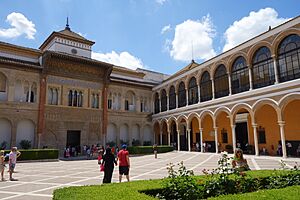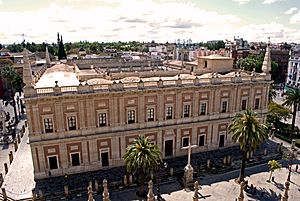Casa de Contratación facts for kids

The Casa de Contratación (which means "House of Trade") was a very important government office in Spain. It was set up in 1503 in the city of Seville. Later, in 1717, it moved to Cádiz. This office was created by the Crown of Castile to manage all trade and travel between Spain and its new lands in the Americas. It was like a central control hub for the Spanish Empire. The Casa de Contratación worked for many years until it was closed down in 1790.
Before the Council of the Indies was formed in 1524, the Casa de Contratación had a lot of power. It handled money matters for trade and solved legal problems related to it. It also decided who could travel overseas. The Casa trained ship pilots and created maps. It even managed the belongings of Spaniards who passed away in other lands. Its full name was La Casa y Audiencia de Indias.
Contents
Why the Casa de Contratación Was Created
The Casa de Contratación was different from companies like the East India Company. Those companies were set up by countries like the Dutch and English. The Casa was a government agency. It collected all taxes from the colonies. It also had to approve every trip for exploration and trade.
The Casa kept secret information about trade routes and new discoveries. It gave licenses to ship captains. It also made sure that trade laws were followed. In theory, no Spaniard could sail anywhere without the Casa's permission. But, people sometimes smuggled goods in the huge Spanish Empire.
Queen Isabella I of Castile created the Casa de Contratación in 1503. This was eleven years after Christopher Columbus first arrived in the Americas in 1492. A person named Ochoa Alvarez de Isasaga was named a special agent for the Crown in 1509. The Casa was similar to Portugal's Casa da India in Lisbon. That Portuguese office was started in 1434.
How the Casa de Contratación Worked

The Casa de Contratación collected a 20 percent tax on all precious metals coming into Spain. This tax was called the quinto real, or royal fifth. Other taxes could be as high as 40 percent. These higher taxes helped pay for naval protection for the trading ships. Sometimes, taxes were lowered to 10 percent. This happened during difficult financial times to encourage more trade. Every ship had to have a clerk. This clerk kept detailed records of all goods and transactions.
The Casa de Contratación also created and managed the Padrón Real. This was the official and secret Spanish map. It was used as the main map for every Spanish ship in the 16th century. The map was always being improved from its first version in 1508. It was like Portugal's Padrão Real map. The Casa also had a school for navigation. New pilots, or navigators, were trained there for ocean voyages.
Spain used a system called mercantilism. This system meant that the government controlled trade. The Casa in Seville was in charge of this. A group of merchants in Seville, called the Consulado de mercaderes, worked with the Casa. Trade with overseas lands was done through special trade fleets. These were the famous Flota de Indias and the Manila galleons.
Changes and End of the Casa
By the late 1600s, the Casa de Contratación had become very slow. The Spanish Empire was also struggling. This was mainly because Spain could not afford to fight wars in Europe and manage a global empire at the same time. Often, the riches from Manila and Acapulco were already promised to Spain's creditors. This happened even before the Manila galleons arrived in port.
In the 1700s, new kings from the Bourbon family came to power. They made changes called the Bourbon Reforms. These changes reduced the power of Seville and the Casa de Contratación. In 1717, they moved the Casa from Seville to Cádiz. This made Seville less important for international trade. Charles III further limited the Casa's powers. His son, Charles IV, closed it completely in 1790.
The official end of the Spanish treasure fleets also happened because the Casa was abolished. This brought an end to Spain's very profitable colonial income.
Important Mapmakers at the Casa
The work of making maps at the Casa de Contratación was huge. It was very important for the success of Spain's voyages of discovery. Without good maps, Spain would not have been able to explore and profit from its new lands. The Casa had many mapmakers and navigators (pilots). It also had archivists, record keepers, and administrators. All of them helped create and manage the Padrón Real.
The famous explorer Amerigo Vespucci worked as a pilot at the Casa de Contratación. He made at least two trips to the New World. A special job was created for Vespucci in 1508. He became the piloto mayor (chief of navigation). He trained new pilots for ocean voyages. After he passed away in 1512, his nephew, Juan Vespucci, took over his maps and instruments. Juan Vespucci and Andrés de San Martín were appointed to Amerigo's old job.
In 1524, Juan Vespucci became the examinador de pilotos (Examiner of Pilots). He replaced Sebastian Cabot, who was leading an expedition in Brazil. In the 1530s and 1540s, the main mapmakers at the Casa were Alonso de Santa Cruz, Sebastian Cabot, and Pedro de Medina. They all worked on the Padrón Real.
Another mapmaker, Diego Gutiérrez, became a cosmographer at the Casa in 1554. He also worked on the Padrón Real. In 1562, Gutierrez published a map called "Americae ... Descriptio" in Antwerp. It was printed there because Spanish engravers were not skilled enough to print such a detailed map. Other cosmographers included Alonso de Chaves, Jerónimo de Chaves, and Sancho Gutiérrez.
In the late 16th century, Juan López de Velasco was the first Cosmógrafo-Cronista Mayor (Chief Cosmographer-Chronicler) for the Council of the Indies. He made a master map and twelve smaller maps. These maps showed the worldwide Spanish empire. Even though these maps were not super accurate, they were the best Spanish maps of that time. They were better than maps made by other European countries. However, mapmakers in England, the Netherlands, and Germany kept getting better. By the end of the 17th century, even Spanish thinkers felt that foreign maps were better than their own.
See also
 In Spanish: Casa de la Contratación de Indias para niños
In Spanish: Casa de la Contratación de Indias para niños
- The Virgin of the Navigators, a painting in a Casa de Contratación chapel.
- Llotja
- Merchant guild

